I have about 30 standard 8mm videos which I want to digitize, edit a little, and then turn into DVDs.
I've tried capturing with a $35 kworld USB 2.0 converter via VirtualDub, but the picture is grainy and the colors are washed out compared to what I see on my camera's LCD (or TV). Fiddling with contrast and color settings doesn't help. I'm guessing that the crummy video quality is duo to either the composite video, the cheap USB converter, or VirtualDub (though I doubt it). I plan to try s-video and see if that helps, but I'm guessing the USB converter is the weak link.
So, I plan to buy a camcorder (either Digital8 or MiniDV) and have that perform the analog-to-digital conversion for me. I can then transfer the digital video to the computer via firewire. I don't necessarily need pass-though conversion; recording to digital tape first and then transferring to PC later would be fine. Capture quality is my main concern.
Right now I am trying to decide which Digital8 or MiniDV camera to buy. Some Digital8 cameras would let me play my standard 8mm tapes and automatically convert them to digital, which gets sent to the PC via firewire. MiniDV cameras would require me to play the tapes on my old camcorder, which is then connected to the MiniDV camera, which can either record to tape or pass-through the data to the computer.
Since the Ditital8 approach doesn't involve analog wires, it seems in theory that it would result in a higher quality capture than the MiniDV approach. However, I don't know how noticeable that difference is. MiniDV cameras seem to be better at recording, which gives them an advantage in the long-term (after I've finished capturing all my old videos).
So I need to first make up my mind about Digital8 vs MiniDV, and then pick a camcorder. So here are my questions:
Questions:
1) Which approach is best for converting 8mm to digital: play-with-Digital8 or record-to-MiniDV?
2) Which Digital8 camcorders are best for converting 8mm to digital (or are they all the same)?
3) Which Digital8 camcorders are best for recording new digital video (of the ones that can play standard 8mm)?
4) Which MiniDV camcorders are best for converting 8mm to digital (or are they all the same)?
5) Which MiniDV camcorders are best for recording new digital video (of the ones with s-video input)?
Thanks!
Travis
Try StreamFab Downloader and download from Netflix, Amazon, Youtube! Or Try DVDFab and copy Blu-rays! or rip iTunes movies!
+ Reply to Thread
Results 1 to 30 of 62
Thread
-
-
1) Depends. Some, not all Digital8 camcorders or decks play Video8 at 1x speed to DV. A big advantage is black level is captured correctly to digital level 16. Another advantage is you can play the tapes even if you don't have your old Video8 cam. A MiniDV camcorder needs the "analog pass through" feature to accept analog inputs. Not all have this feature. A negative is analog 7.5IRE black will be captured to digital level 32 (washed out) unless you use a proc amp ahead of the MiniDV or correct levels later in the digital domain.Originally Posted by tripecac
2) The one's with Video8/Hi8 playback capability. Original models all did this. Over time only the top model retained the feature, then last year no models did it.
3) The higher end models sold between 2001 and 2005. Digital8 camera sections never got to prosumer level.
4) The ones with the "analog pass through" feature. They all have the 7.5IRE import problem. Some lack S-Video input.
5) MiniDV camcorders were available at multi thousand dollar price points. The "best" consumer model was the Sony VX-2100. Above that you have the pro line. See www.camcorderinfo.com for reviews.Recommends: Kiva.org - Loans that change lives.
http://www.kiva.org/about -
Travis,
I believe I can see what you're trying to do - archive all those old 8mm video cassettes you accumulated. As one who has been there and done that I would be inclined to lead you in a different direction that the one you're taking. What about the tabletop DVD recorder route? Much quicker, easier and cheaper than most any other option. Do you really want or need to edit those tapes now, or just get them archived and onto DVD? You can always edit the important DVDs later with no quality loss using something like MPEG Video Wizard DVD. I am not aware of any standard 8mm video camera with S-Video outputs so I don't know why you mentioned that, unless you mean to borrow or rent a Hi-8 camera with such an output. I once had a cheap Canon Hi-8 with built in TBC that would have been the best unit to use to transfer your regular 8mm tapes to a DVD recorder. Anyway, I'd suggest putting off the editing until later and concentrate on getting those tapes onto DVD in the best fashion possible. Ask around, maybe you can find someone who still has a Hi-8 unit you can borrow, and new DVD recorders can be had for under $100 if you don't already have one (hey, you could borrow one of those too!).
MikeMichael
phototools.co.nr -
Thanks for responding!
From what edDV's saying, it sounds like Digital8 will do a better job of capturing, at least as far as black levels go. The main Digital8 models I've been considering are TRV350, TRV460, TRV480. Those seem to be the most popular later models with analog playback.
However, on eBay their "buy it now" price is usually around $300. That's almost as much as a new mid-level MiniDV from Amazon. That's what got me thinking about skipping Digital8 and going for MiniDV. However, if the capture quality of MiniDV is noticeably weak, then I guess I need to also get a Digital8 (or some other capture device).
Is one of these going to do as good a job of capturing as a MiniDV camera? How about versus a Digital8 camera (with the better black)?What about the tabletop DVD recorder route?
If the capture device is burning DVDs on the fly, that means it needs to compress and write a certain number of bits per second, and that number is probably lower for DVD than a hard disk, or maybe a MiniDV tape, right? I don't know the numbers, but I have a (possibly mistaken) impression that DVD recorders won't do as nice a job of capturing as a camcorder or hard disk, due to the amount and hastiness of compression. I have no idea how noticeable that difference is. All I know is that my current capture method (composite video to kworld USB capture device) looks very bad, so I want a method that will be dramatically better than what I have now. If you think a DVD recorders is much better than what I have now, then I'll definitely take a look. Are there any particular models that you would recommend?
I was planning on doing 2 editing passes. The first would have only simple edits like removing dead air (where I forgot to turn off the camera), etc. The second pass would tighten up gaps, boost volumes, add titles and chapters, etc. I have Sony Vegas for editing, and am chomping at the bit; the editing is the fun part!Do you really want or need to edit those tapes now, or just get them archived and onto DVD?
Sorry, by "standard 8mm" I meant "analog 8mm". My Sony CCD-TRV108 has s-video output; it's a Hi8 camera. My tapes were recorded on a different camcorder, which was (I think) standard 8mm rather than Hi8.I am not aware of any standard 8mm video camera with S-Video outputs
I've called Sony a couple times and each time they recommend I get a video walkman. Those things cost around $400, which is around what I was expecting to spend on a camcorder. I suppose after I'm done digitizing, I could sell it on eBay, but I would prefer to get more "bang for the buck", which I would with a camcorder.
Does that sound like a realistic attitude? Or is it better to have separate devices for capturing old video and recording new video? -
Vegas can make the corrections to black level. You have these choices.
1. Get a Digital8 or Sony GV-D200/D400 Digital8 deck, make your dubs and then resell on ebay. Then get the best MiniDV you can afford.
2. Get a Canopus ADVC-55/100/110 and resell on ebay. Maybe someone rents these.
3. Get an appropriate MiniDV model, make your dubs and correct in Vegas.
The DVD recorder is a good idea for those that don't want to do much editing. You could do the first pass garbage removal type editing on one of these. Black performance varies but is better on recent recorders. Cap would be to MPeg2 about 8000Kbps maximum which is OK as a finished product but not what you want for Vegas editing.Recommends: Kiva.org - Loans that change lives.
http://www.kiva.org/about -
Is color-correcting in Vegas straightforward and low-maintenance? Does it need to be done at capture time or edit time (I'm guessing the latter)? Would I find or create a preset and then apply it to all the videos I capture? Or would I have to manually correct each video (and possibly each scene within a video)?
Since I've never sold on eBay before, this seems like the least hassle in the long-run. Finding a good MiniCV camcorder with s-video input and firewire output is a bit tough, though; most seem to be older models, although the Sony HC96 doesn't look too bad. It costs around $700, though, which is a bit steep for "old" technology.Get an appropriate MiniDV model, make your dubs and correct in Vegas.
$700 for a new MiniDV vs $300 for a used Digital8... It seems like a tough choice. If I could find a good new MiniDV (with s-video in and firewire out) for less than $500 then I think I'd just go with that. Gotta keep looking...
-
Check out camcorderinfo.com for reviews. Pick the best one with analog inputs. I'm fairly sure some Canon's support analog in. The small cams use combo breakout cables so check the specs. At $700 you are close to HDV territory. The Canon HV20 is the choice there but I haven't tested it for SD analog import. Someone said it only supports composite.Originally Posted by tripecac
I normally cap DV with WinDV then import the file to Vegas and work on it from the DV timeline. It has good correction filters. You can export to Virtualdub/avisynth if you want to go that route. For that see this thread.
https://forum.videohelp.com/topic352511.htmlRecommends: Kiva.org - Loans that change lives.
http://www.kiva.org/about -
Thanks for the info!
I've always got a tab open to camcorderinfo.com... Great source of info! I just wish there were more tables of feature comparisons, or a feature-specific search engine, something to make it easy to find out which cameras have s-video inputs.
I use VirtualDub for capture only, since my version of Sony Vegas doesn't support analog capture. I'll check out WinDV once I get that far. Right now I still need to get a camera. -
Then I suggest you read the thread above. DV capture to Virtualdub is very problematic especially for consumer camcorder capture. I suggest WinDV to a DV-AVI file, then use Vegas for levels setting and RGB conversion if you want to use Virtualdub/avisynth. Correct black levels before you convert to RGB. The SonyDV codec is among the best and Vegas scopes are invaluable for monitoring signal levels.Originally Posted by tripecacRecommends: Kiva.org - Loans that change lives.
http://www.kiva.org/about -
For DV capture, could I just use Vegas? (I'm using VirtualDub for analog capture since Vegas doesn't let me do that). I intend to do all the editing in Vegas, since I'm familiar with that. Vegas for editing, and DVD Architect for the DVDs. Does that sound solid?
I found a Sony HC96 (new) for $520, and read that there's a $20 adaptor for providing s-video input. So that's $540 (plus tax and shipping) for a good MiniDV... That's almost my comfort zone. However, there seems to be ambiguity as to whether or not the s-video input actually works. Some reviewers say yes, some say no. Not very reassuring! -
I use the Vegas capture program for batch and other large tasks but find it cumbersome for quick tasks. WinDV is quick, easy and free. There is no quality issue. I just drag the DV-AVI file to the timeline.
Select a camcorder with care. Read all the user comments. I'm unfamiliar with current consumer models. A Panasonic GS400 is a great used find if priced right.Recommends: Kiva.org - Loans that change lives.
http://www.kiva.org/about -
Okay, good news!
Yesterday I bought a digital camcorder on craigslist (for only $150). It's a Canon ZR40, from 2002 (the same year as my analog 8mm camcorder). I remember it being mentioned in an article about 8mm conversion, and decided it was a safe bet.
I also bought a firewire and svideo cable so now my setup looks like this:
analog camcorder --svideo--> digital camcorder --firewire--> pc
I can record from the analog camcorder to the digital camcorder, and then transfer to the pc via firewire, which I capture using WinDV (Thanks edDV!)
The resulting AVI files not only look dramatically better than the ones I got using the kworld USB capture device, but the files are smaller.
So I am happy, so far!
The Canon ZR40's low-light recording is much worse than my analog camcorder, but I don't mind, since I can always use the analog camcorder if I feel like it.
I have other questions, but I think I will post then in different topics, since they don't relate to the digital8 vs minidv choice anymore.
Thanks for your help!!! -
I used HC96 with separately bought s-video cable. I like results but that the only thing I used for transfer my Hi8 tapes so I have nothing to compare with.I found a Sony HC96 (new) for $520, and read that there's a $20 adaptor for providing s-video input. So that's $540 (plus tax and shipping) for a good MiniDV... That's almost my comfort zone. However, there seems to be ambiguity as to whether or not the s-video input actually works. Some reviewers say yes, some say no. Not very reassuring!
-
The Canon ZR40 (MiniDV camcorder) is doing a great job of digitizing the analog 8mm, much better than my old kworld USB 2.0 device.
Here's a link to an image showing the difference:
http://tripalot.com/issues/images/20080702-capture-diffs.jpg
(I tried to attach the image but it apparently didn't work).
As you can see, the Canon ZR40's conversion is dramatically better! I think I'm at the "good enough" point now, and can get on with the actual capturing and editing.
Thanks for your help!
-
Okay, after several more tests, I notice that although the Canon ZR40's capturing is miles better than that of the kworld USB 2.0, the picture still seems a little low-res and washed out when I maximize it on the screen.
Does standard 8mm always look faded and blurry when you view it at 1280x1024? Or is there room for improvement in my capturing? -
I just noticed 2 more things:
1) When I plug the analog camcorder into the TV (via composite cables), video looks good. Colors are normal, resolution is what I'd expect. So, the analog camcorder is outputting good video.
2) When I plug the analog camcorder into the DV camcorder and view playback on the LCD, colors look okay (though maybe a tiny bit fade), and resolution looks the same. It's hard to tell if signal is being degraded, because the LCD screen is so small.
3) When I plug the DV camcorder into the TV, it looks fine.
4) When I plug the DV camcorder into the PC via firewire and monitor its [live] video in WinDV or Vegas, the colors are washed out (compared to what's on the TV) and the resolution looks degraded. If I capture to an AVI, the AVI is also washed out. This happens for both live video (camera mode) video and tapes (MiniDV).
So basically, whenever I view video on the computer, it looks washed out.
These tests suggest that the problem is either in:
a) the DV camera's transmission of video over firewire
b) PC hardware (bad firewire port?)
c) PC software (bad capture app?)
Since both WinDV and Vegas are showing the same washed-out picture, the problem doesn't seem to be application specific. Could some driver or codec somewhere be washing out the picture? -
Okay, I did another test. This one was surprising!
I burned my "washed out" test captures to DVD. I then connected both my DVD player and my DV camera to the TV (via an A/B switch). I then found the same scene on both the DVD player and the DV camcorder, and toggled back and forth.
And guess what... The colors are the same! No obvious differences in resolution either.
So this means the colors that I am seeing on my PC are not representative of what appears on the TV. I'm guessing that either my monitor or video card is making them look "washed out". Weird!
Has anyone else ever noticed this? -
Pass-through capture to a DV camcorder unfortunately doesn't adjust for NTSC setup. This results in 7.5 IRE black capturing to digital level 32 instead of 16. You need to correct the black level with the Vegas "Levels" filter or the NTSC capture will appear washed out.Originally Posted by tripecac
See this thread
https://forum.videohelp.com/topic319733.html
Also watch the JVC tutorial on digital black levels referenced in that thread.Recommends: Kiva.org - Loans that change lives.
http://www.kiva.org/about -
I don't think that's his main problem edDV. What he's reporting is simply the difference between watching video on a TV (handles interlacing properly, handles SD properly, has appropriate gamma and colours) and a PC (all of the above: slightly or very wrong!).
There is nothing wrong with your PC. That's just the way it is. PC monitors are calibrated very differently from TVs. Typing black text onto a white background in word would be very painful on the eyes otherwise!
Cheers,
David. -
I agree monitoring method is his first issue, but analog NTSC "pass-through" captures to DV still need black correction from 32 to 16 or they will appear washed out. This wouldn't be an issue for PAL capture.Originally Posted by 2BdecidedRecommends: Kiva.org - Loans that change lives.
http://www.kiva.org/about -
This makes sense!PC monitors are calibrated very differently from TVs.
I wonder why NetFlix and DVDs look decent on my monitor. I'd think they'd look washed out. I've never done a side-by-side comparison of monitor vs TV before, though, so maybe the difference is there.
I don't see any color differences on the TV between the original DV and the captured-and-burnt DVD. However, the video segment I am comparing was itself captured by the DV camera (from an analog camcorder), so it would have the same washed-out problem, right? Could I be comparing one washed-out copy to another?analog NTSC "pass-through" captures to DV still need black correction from 32 to 16 or they will appear washed out.
So I think black correction is a good idea. In theory, it would make my DVDs look *better* than the DV in the camcorder, right? -
The difference will look something like this. Source here was a very noisy analog cable system capped S-video through a Digital8 camcorder. This should be "rendered" at the same time you encode to MPeg2 for DVD. The picture should look much better than this computer screen cap when viewed on your TV.
Left half picture is as captured (black at 32). Right shows black lowered to ~16. Look at the microphone.
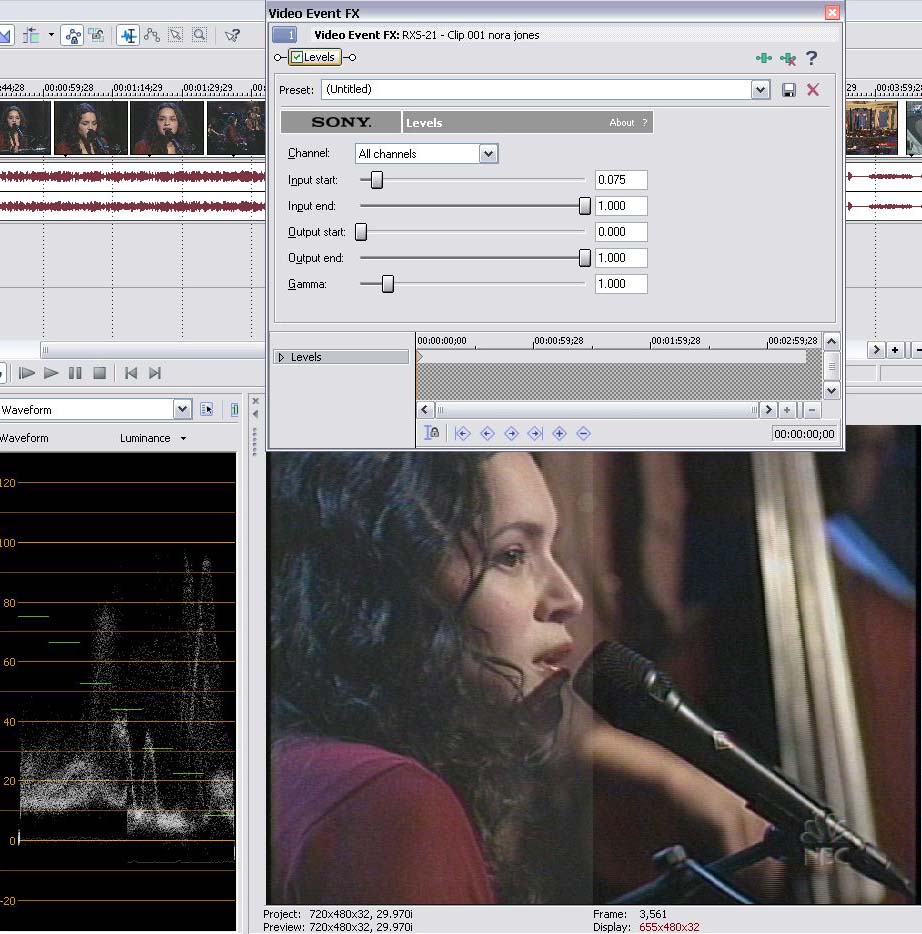
BTW: Get your scopes working and show us some screen cap samples similar to this Video8 cap.
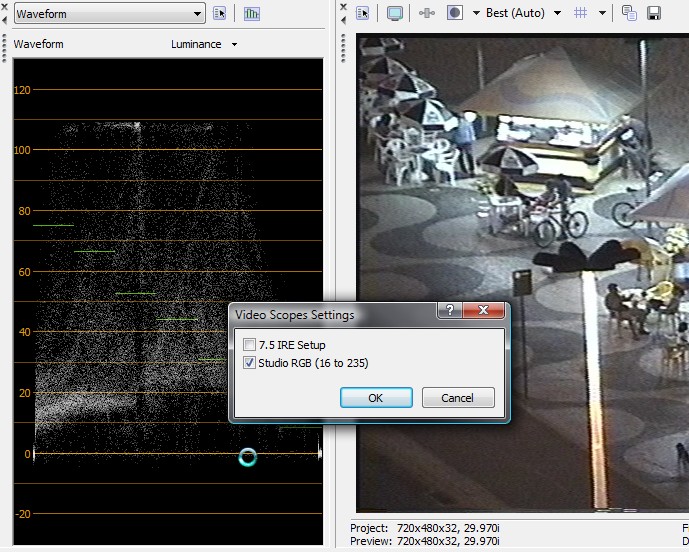 Recommends: Kiva.org - Loans that change lives.
Recommends: Kiva.org - Loans that change lives.
http://www.kiva.org/about -
Eek, I don't have any scopes. I'm just using Sony Vegas Movie Studio. It sounds like I need to upgrade to platinum. Are the scopes worth it?
-
You need full Vegas for the scopes I think.Originally Posted by tripecac
Post some caps here. Does Movie Studio have the "Copy Snapshot to Clipboard" button?
If so cap some examples, paste to a photo editor and save as jpg.
Then I'll look at your levels.
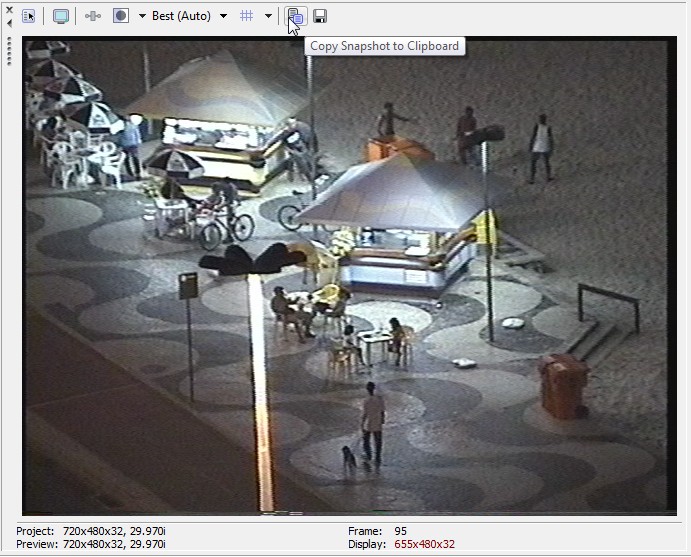 Recommends: Kiva.org - Loans that change lives.
Recommends: Kiva.org - Loans that change lives.
http://www.kiva.org/about -
Ok, here are some screen grabs:

( http://tripalot.com/issues/images/20080703-capture-grabs.jpg ) -
Individual frames full size (720x480) would be more helpful.
Recommends: Kiva.org - Loans that change lives.
http://www.kiva.org/about -
Recorded w/ DV camcorder:
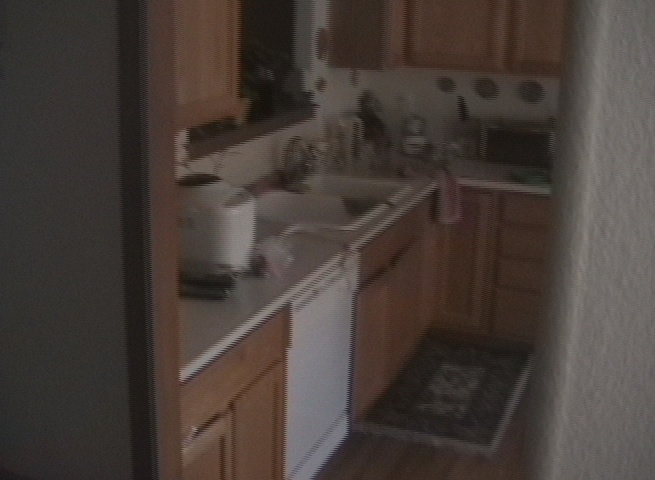

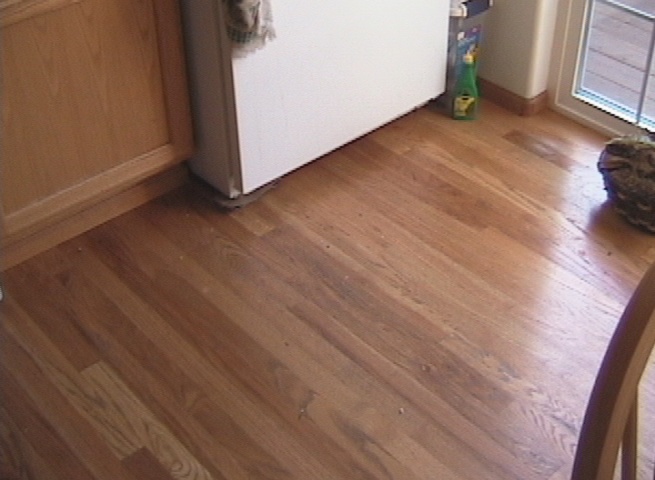
Recorded w/ analog camcorder, and then captured to DV camcorder:
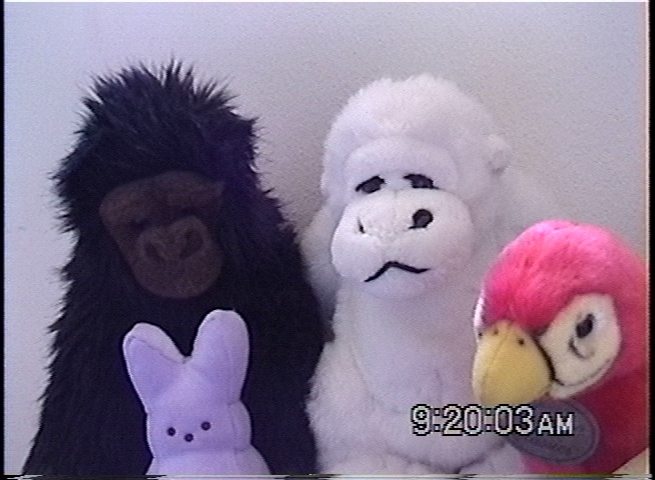
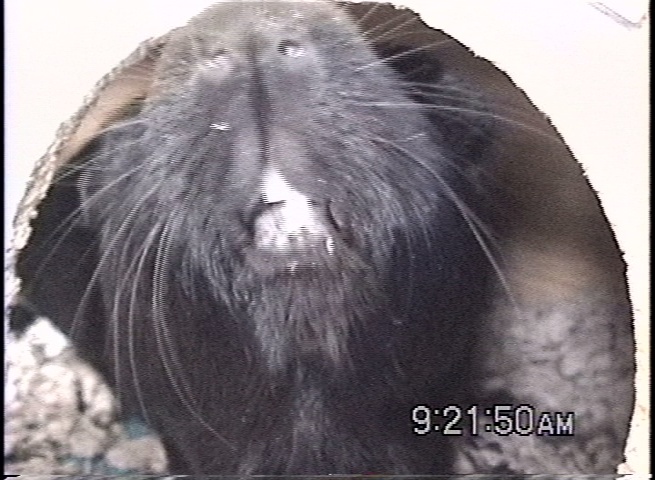
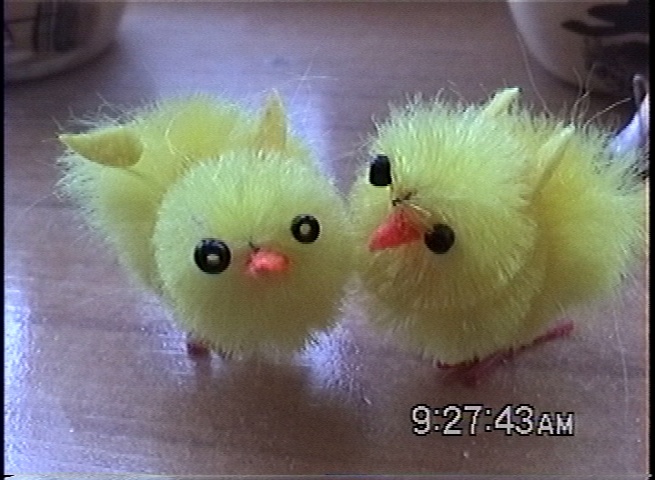
-
I'm impressed with the Canon ZR40. Unlike the NTSC Sony, JVC and Panasonic consumer camcorders that I've used, the ZR40 does pass-through capture with correct black level (digital16).
Your an1.jpg shows technically correct black and white (contrast). The reference indicator for the analog source is the black stripe down the left and right side. Broadcast TV picture width is ~704x480 so capture at 720x480 pics up ~8 pixels of blanking left and right. For NTSC, blanking should be 7.5% lower than black. That dot you see below zero% on the waveform monitor indicates the correct blanking level for analog NTSC.

Your Hi8 camcorder wasn't as successful setting black and contrast (iris+gain) for the an2.jpg frame. Most camcorders set exposure with center weighting. This subject had lots of black in the center so the camera opened the iris too far causing light blacks and over white sky.
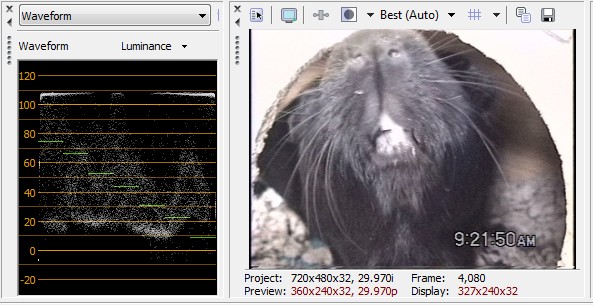
You can improve this exposure with the levels and other filters. Here I used the levels filter to lower black to 0% (digital 16) and bring white down to 100% (digital 235). You would adjust further to your preference while watching the TV monitor.

You should adjust your TV to the DV SMPTE color bar found in the Vegas media generator.

You set black with the TV brightness control using the 3 pluge bars (see arrow below red bar). Set black to the point where the two left bars appear equally black but the right bar remains brighter than the other two. White level is set with the TV contrast or "picture" control. Set the white box to below the point where it no longer gets brighter. For CRT TV sets, set white to just below the point where the white box "blooms" or changes size. For some TV sets the brightness and contrast controls affect each other so adjust for best balance favoring correct black.
Saturation and Hue are set to your taste. They can be set with greater precision with special blue filters.
Once you get the TV set to the reference bar, you don't touch these controls again for the session. You only adjust the filters. Next I'll look at your digital caps.Recommends: Kiva.org - Loans that change lives.
http://www.kiva.org/about
Similar Threads
-
Will a Digital 8 camcorder read 8mm tape?
By Tenacguy in forum Camcorders (DV/HDV/AVCHD/HD)Replies: 4Last Post: 10th Jun 2009, 13:24 -
Help with old 8mm camcorder tapes
By AmandaBMidlands in forum Portable VideoReplies: 2Last Post: 11th Nov 2008, 08:43 -
What is the best camcorder for 8mm to dvd.
By krlorenz in forum Camcorders (DV/HDV/AVCHD/HD)Replies: 0Last Post: 30th Dec 2007, 13:58 -
Problem with old 8mm camcorder
By neilf1234 in forum Newbie / General discussionsReplies: 15Last Post: 26th Jul 2007, 08:04 -
Record 8mm Home Movies w/Digital Camcorder?
By stahlhart in forum Newbie / General discussionsReplies: 6Last Post: 28th May 2007, 15:28




 Quote
Quote